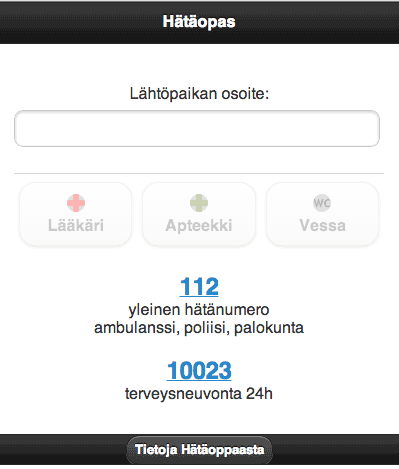Text Petja Partanen
The service map of the Helsinki Metropolitan Area, originally designed as an internal reporting tool to the directors of the Department of Social Services, became eventually an open data resource for all citizens. The information on the 10,000 customer service points are free to use and reuse.
From management database to civic open data
In 2007, the City of Helsinki Department of Social Services had a wish to collect information about all of its service points in one database in order to facilitate the reporting related to the management of the department.
The greatest challenge of the so-called service point register was to obtain up-to-date information for the database. The project manager, Mirjam Heikkinen, figured out that results should be demonstrated instantly. In co-operation with partners SITO and Affecto, a map service was built that displayed the information in the database instantly on the map.
”As I went from one department to the next, I showed them that such-and-such services are already on the map but your services seem to be absent.”
It was soon decided that the project would be expanded to include all the services in the City of Helsinki. In summer 2011, Espoo, Vantaa and Kauniainen had joined the service. The project management also came up with the idea that the service map could serve not only the city management but also all citizens online.
Inspired by this web service, the researchers of linked data at Aalto University became interested in categorised municipal service data and requested a permission to use it. This coincides with the launching of Helsinki Region Infoshare, and there was increasing enthusiasm within
the City of Helsinki’s IT management to proceed with unlocking data. The first open interface to the service point data came into existence virtually through voluntary work, built by VTT Technical Research Centre of Finland and Affecto, tested by Aalto University.
”None of us knew if somebody else would be interested in using it”, says Heikkinen.
It was a surprise how many are in fact using it. In March 2012, over 300,000 searches of the service point register were made through the REST interface.
Not only the users but also the producer of the data has to benefit from the unlocking. For Mirjam Heikkinen, the greatest benefit has been the growing amount of feedback. Mistakes in the data are found quickly by the users, and the quality of the database is improving.
Palvelukartan REST-rajapinta
The Service Point Register of the Helsinki Metropolitan Area has data of all the 10,000 public services of the area, from statues in the parks to bottle collection points; from tax offices to dog parks. Through the interface, anyone can use the constantly updated information of the Helsinki Metropolitan Area service point register in their web applications.
This is how the data was opened
2007 The largest service provider in the city, the Department of Social Services, has the
idea to list the information about all its service points in a single data register.
2008 The central administration of the City of Helsinki takes interest in the project.
2009 In January, the database is completed and an online map showing all the social services of the city is produced. Project Manager Mirjam Heikkinen is tasked to extend the project to cover all the services of the city.
2010 In March, Mirjam Heikkinen talks about the service map to the mayors of the other cities
in the Helsinki Metropolitan Area. The other cities join the project. Researchers of semantic
web in the Aalto University request for an open interface to the service point database.
2011 In June, a REST interface is published as an answer to the researchers’ request.
2012 A second version of the REST interface is published. Around 300,000 queries are made monthly
through the interface – approximately the same amount as in the city’s online service map.
•
The texts of the publication are licensed under the 'HRI-nimeä' attribution. All reuse of the material must be accompanied by the name of the author (Petja Partanen or Terhi Upola) and the publisher (Helsinki Region Infoshare).
Datan avaaja

Mirjam Heikkinen
Project Manager, City of Helsinki, Economic and Planning
Center, IT Division, Development Unit
Supplier Affecto Finland Oy
Release date
9 June 2011
What did it cost?
”It cost 20,000 euro to open a REST interface.
The whole data system of the service point
register cost about 2 million euro.”
Tips for those planning to open their data?
1. ”Even if the information is not perfect somebody will certainly need it.”
2. ”The experts at Helsinki Region Infoshare give advice in practical matters.”
3. ”Don’t try to do everything at once. Excel files are a good starting point.”
Your favourite service that uses open data?
“Verokuitti. It would be even better if it also showed
the revenue and spending of municipalities.”
Why is it important to unlock data?
“ Young application developers
often have great ideas and
solutions that the city could not
put into practice on its own.””

Where is the data used?
Hätäopas
A mobile application which helps you to find the nearest doctor or health center, pharmacy or public toilet. It locates the user (or you can type in an address) and displays on the map the nearest service points and their contact information.
http://demo.seco.tkk.fi/hataopas/
BlindSquare
The award-winning application of augmented reality which helps the visually impaired to navigate in city surroundings through voice guidance. In the Helsinki Metropolitan Area, BlindSquare also makes use of the database of the service map.
http://blindsquare.com/